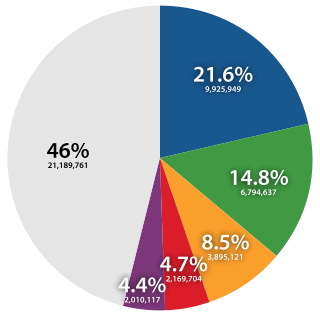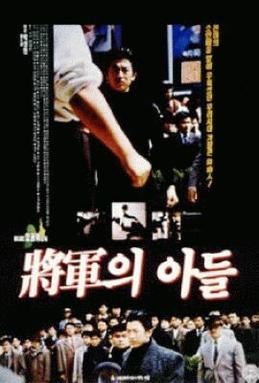
The Korean War was fought between North Korea and South Korea; it began on 25 June 1950 when North Korea invaded South Korea and ceased after an armistice on 27 July 1953. North Korea was supported by the People's Republic of China and the Soviet Union while South Korea was supported by the United Nations Command (UNC) led by the US.

Busan, officially Busan Metropolitan City, is South Korea's second most populous city after Seoul, with a population of over 3.3 million inhabitants as of 2024. Formerly romanized as Pusan, it is the economic, cultural and educational center of southeastern South Korea, with its port being South Korea's busiest and the sixth-busiest in the world. The surrounding "Southeastern Maritime Industrial Region" is South Korea's largest industrial area. The large volumes of port traffic and urban population in excess of 1 million make Busan a Large-Port metropolis using the Southampton System of Port-City classification. As of 2019, Busan Port is the primary port in Korea and the world's sixth-largest container port.
The year 1990 in film involved many significant events as shown below. Universal Pictures celebrated its 75th anniversary in 1990, despite its actual 75th anniversary taking place in 1987.

Jajang (590–658) was a monk born Kim Seonjong, into the royal Kim family, in the kingdom of Silla. He is credited with founding the temple of Tongdosa in 646 CE, near in what is now Busan, South Korea, and played a significant role in the adoption of Buddhism as the national religion of Silla. His biography is told in the anthology of Korean Buddhism: "Jogye Culture Web", Vol 10.

Oseam is a 2003 South Korean drama/religious animation directed by Sung Baek-yeop. It is based on a novel by Korean author Jeong Chae-bong, who has described it as being a fairy tale for adults. The title means "five-year-old temple."

Baekdamsa is a Buddhist temple in Inje County, Gangwon province, South Korea. It was originally built in the 7th century, but because of war and natural disasters has been rebuilt numerous times since then. The present version was completed in 1957. Additionally, the name has also changed over time. Originally called Hangyesa, the new name reflects the "100 pits from Daecheongbong Peak to the temple".

Jung is a Latin alphabet rendition of the Korean family name "정", also often spelled Jeong, Chung, Joung or Jong. As of the South Korean census of 2015, there were 2,407,601 people by this name in South Korea or 4.84% of the population. The Korean family name "정" is mainly derived from three homophonous hanja. 鄭 (2,151,879), 丁 (243,803) and 程 (11,683). The rest of the homophonous hanjas include: 政 (139), 桯 (41), 定 (29), 正 (22) and 情 (5).

The Blue Dragon Film Awards is an annual awards ceremony that is presented by Sports Chosun for excellence in film in South Korea.
This is a list of films by year produced in the country of South Korea which came into existence officially in September 1948. The lists of Korean films are divided by period for political reasons. For earlier films of united Korea see List of Korean films of 1919–1948. For the films of North Korea see List of North Korean films. For an A-Z list of films see Category:Korean films.

General's Son is a 1990 South Korean crime film directed by Im Kwon-taek. It stars Park Sang-min as Kim Du-han, a gangster who discovers that he is the son of General Kim Jwa-jin. The film is the first in a trilogy, followed by General's Son II (1991) and General's Son III (1992).
The Chunsa Film Art Awards have been presented in South Korea since the founding of the prize by the Korea Film Directors' Society in 1990. The awards take their name from the pen name of the early Korean actor and filmmaker from the silent film era, Na Woon-gyu. Prizes are given for Best Film, Best Director, Best Actor, Best Actress, Best Supporting Actor, Best Supporting Actress, Best New Director, Best New Actor, Best New Actress, Best Screenplay, Best Cinematography, Best Music/Score, Best Lighting, Best Editing, Best Art Direction, and Technical Award.
Park Chul-soo was a South Korean film director, producer, screenwriter and occasional actor. He was one of the most active filmmakers in Korean cinema in the 1980s and '90s.
Lee Hye-young is a South Korean actress. She is the daughter of celebrated film director Lee Man-hee, who died in 1975 when she was in middle school. Lee began her acting career in 1981 at the age of 18 through a local musical theatre production of The Sound of Music. Since then she has performed in theater, feature and short films, and television. She was one of the most prominent South Korean actresses in the 1980s, starring in films such as The Blazing Sun (1985), Winter Wanderer (1986), Ticket (1986), The Age of Success (1988), North Korean Partisan in South Korea (1990), Fly High Run Far (1991), Passage to Buddha (1993), and No Blood No Tears (2002). Lee also played supporting roles in the Korean dramas I'm Sorry, I Love You (2004), Fashion 70's (2005) and Boys Over Flowers (2009).
Freezing Point is the debut novel of Japanese novelist Ayako Miura, first serialized on Asahi Shimbun between 1964 and 1965. The novel won Asahi Shimbun's Ten Million Yen Award.








